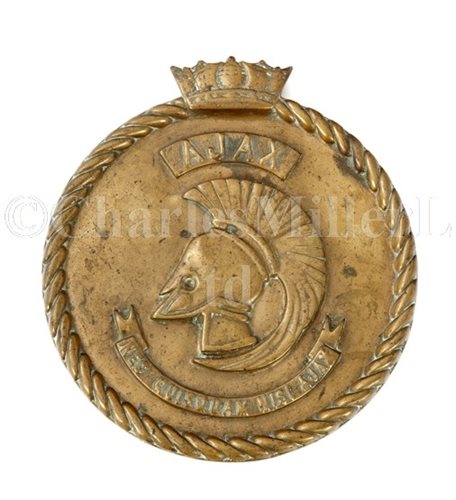30th Oct, 2013 12:00
Maritime and Scientific Models, Instruments & Art (Powerful)
109
[M] A 6IN.-GUN TOMPION PLATE FROM H.M.S. AJAX...
embossed with the Corinthian helmet of a Greek warrior with motto inscribed NEC QUISQUAM NISI AJAX ("None but Ajax can overcome Ajax"), rope border with Naval Crown to top and two thread-holes to the reverse -- 8in. (20.5cm.) diameter
In December 1939, three British cruisers - Ajax, Achilles and Exeter, under the command of Commodore Henry Harwood - formed one of various task forces searching the South Atlantic for the German pocket-battleship Graf Spee which had been preying on the Allied merchant shipping since soon after the War began. Harwood believed Graf Spee would be attracted to the busy shipping lanes off the estuary of the River Plate and his intuition proved uncannily accurate when he sighted his adversary on 13 December. Splitting his force to sail either side of Graf Spee, Harwood went into action immediately. Within half an-hour, all three of his cruisers had been damaged, with Exeter and Ajax so severely mauled that Harwood was forced to retire. Instead of pursuing his quarry when he was in a position either to defeat them or to escape, Captain Langsdorff took Graf Spee into the neutral port of Montevideo where he was allowed to remain for a few days. Believing that he was boxed in by a superior force which was growing by the day, Langsdorff took his ship out into the Plate estuary on 17 December and scuttled her. A somewhat hollow victory for the Royal Navy, the three cruisers had nevertheless fought valiantly against a much more powerful enemy whose sinking provided a sorely-needed boost to British morale as the War gathered momentum. Ajax was decomissioned in February 1948 and broken at Newport November 1949.
Sold for £521
Estimated at £250 - £350
(inc. buyer's premium of 24%)
Condition Report
Despite being unpolished at present, crown and inscriptions show signs of wear from routine polishing.
We are pleased to provide you with a general report of the condition of this property. Since we are not professional conservators or restorers, we urge you to consult with a restorer or conservator of your choice who will be better able to provide a detailed, professional report. Prospective buyers should inspect each lot to satisfy themselves as to condition and must understand that any statement made by Charles Miller Ltd is merely a subjective, qualified opinion. Prospective buyers should also refer to any Important Notices regarding this sale, which are printed in the Sale Catalogue. NOTWITHSTANDING THIS REPORT OR ANY DISCUSSIONS CONCERNING A LOT, ALL LOTS ARE OFFERED AND SOLD “AS IS” IN ACCORDANCE WITH THE CONDITIONS OF BUSINESS PRINTED IN THE SALE CATALOGUE.
embossed with the Corinthian helmet of a Greek warrior with motto inscribed NEC QUISQUAM NISI AJAX ("None but Ajax can overcome Ajax"), rope border with Naval Crown to top and two thread-holes to the reverse -- 8in. (20.5cm.) diameter
In December 1939, three British cruisers - Ajax, Achilles and Exeter, under the command of Commodore Henry Harwood - formed one of various task forces searching the South Atlantic for the German pocket-battleship Graf Spee which had been preying on the Allied merchant shipping since soon after the War began. Harwood believed Graf Spee would be attracted to the busy shipping lanes off the estuary of the River Plate and his intuition proved uncannily accurate when he sighted his adversary on 13 December. Splitting his force to sail either side of Graf Spee, Harwood went into action immediately. Within half an-hour, all three of his cruisers had been damaged, with Exeter and Ajax so severely mauled that Harwood was forced to retire. Instead of pursuing his quarry when he was in a position either to defeat them or to escape, Captain Langsdorff took Graf Spee into the neutral port of Montevideo where he was allowed to remain for a few days. Believing that he was boxed in by a superior force which was growing by the day, Langsdorff took his ship out into the Plate estuary on 17 December and scuttled her. A somewhat hollow victory for the Royal Navy, the three cruisers had nevertheless fought valiantly against a much more powerful enemy whose sinking provided a sorely-needed boost to British morale as the War gathered momentum. Ajax was decomissioned in February 1948 and broken at Newport November 1949.
Auction: Maritime and Scientific Models, Instruments & Art (Powerful), 30th Oct, 2013
